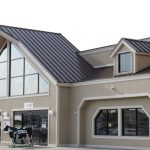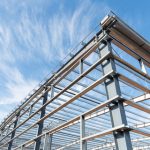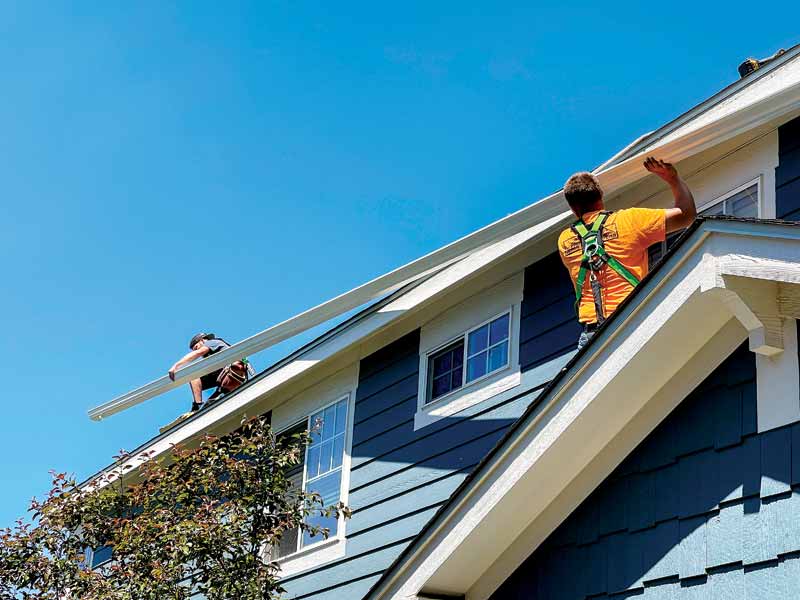
Most homeowners think about gutters only when they are damaged or need cleaning. Many do not realize they protect the foundation of a house, prevent damage to external walls and basement flooding, and direct water away from lawns and gardens.
While gutters are essential, the type of gutter may be equally important. Prefabricated gutters dominate the DIY market. However, using a portable rollformer to manufacture seamless gutters on-site, offers significant advantages to gutter contractors and customers. Firstly, there are differences between the DIY-friendly traditional and professionally manufactured seamless gutters.
Traditional versus seamless gutters
Traditional or sectional gutters are common and typically used for DIY installation. These prefabricated gutters come in 3.04 x 6.1 m (10 to 20 ft) sections, attached by connectors and caps, with droplet outlets intersecting with downspouts. They can be purchased from distributors, manufacturers, or local hardware stores.
Pros and cons of traditional gutters
Pros
As mentioned, traditional gutters are common for DIY installation. They can be cut with a saw to fit any house. Also, they are available in a variety of materials—including aluminum, vinyl, stainless steel, and copper—and are offered in a wide range of colors.
DIY kits are affordable and relatively easy to install, depending on the gutter material and the homeowner’s skills. However, they only come in half-round or K-style, so homes built without any fascia boards will require professional installation.
Cons
Wherever there are seams, there will be leakage. Since traditional gutters are connected by joints, more water will likely seep through. Debris is prone to getting caught in the seams, increasing the likelihood of damage.
Traditional gutters require frequent maintenance, including repairs and replacement of damaged sections. They do not hold up well in severe storms and can separate at the seams. Traditional gutters last 10 to 15 years, compared to seamless gutters, which can last anywhere from 25 to 100 years, depending on the material.
Traditional gutter installation
A DIY gutter project may sound easy to some homeowners—simply nailing gutter sections to the fascia board of their home. While installing traditional gutters can be a DIY project, it requires a lot of planning and additional investment on the part of the consumer. It is essential to know the following:
- The length of the gutter run and where the downspouts will be set.
- Where the water needs to flow to protect the house and property.
- How to inspect fascia and soffit for rot (removal and replacement may be necessary).
- The best gutter profile and material for their climate and situation.
- Where and how to properly install hangers along the roofline.
- How to use a hacksaw or tin snip to cut the lengths to size.
- How to notch the gutter.
- How to attach the gutter sections with hangers and screws or rivets.
- How to properly apply a sealant to seal the joints and connections.
- How to make repairs or replace gutter sections if they become damaged.
Further, check any local building codes to ensure compliance. In short, consumers should have some basic knowledge of working with roofing materials and how water can best flow away from the home. Otherwise, even if the gutter system has been installed properly, there will be a risk of property damage.
Seamless gutters
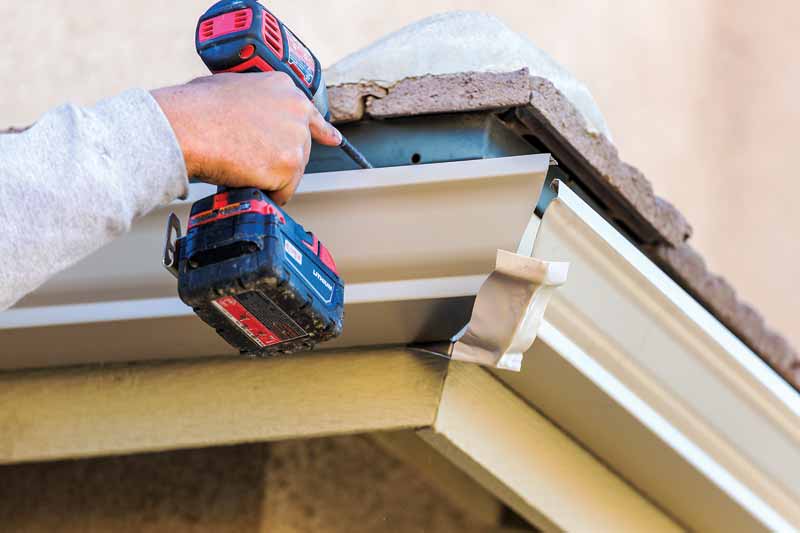
Seamless gutters are installed by a professional using a portable gutter machine on-site. Depending on the type of gutter, it is generally nailed to the fascia board running along the roofline. Houses with no fascia boards will require a fascia gutter that can hang from the framing. Seamless gutters are custom fitted to the house by a professional who understands where the water must flow to protect the home and landscape.
Pros and cons of seamless gutters
Pros
Gutters produced on a portable rollformer are seamless, so they are less likely to suffer leakage or storm damage, meaning they can better protect the structure and property. Also, due to their durability, seamless gutters will often outlast traditional gutters by decades.
Like their traditional counterparts, seamless gutters come in many materials and colors. However, they offer more profiles than traditional gutters, including K-style, box, fascia, and half-round.
Seamless gutters also present a sleeker overall appearance. Whereas seams tend to sag and leak, seamless gutters retain their shape. While many customers prefer their gutters to blend into the roofline, those who want a more ornamental look can choose copper, accentuating the roofline while providing a strong, durable gutter.
Seamless gutters require less maintenance and do a better job of preventing damage to external walls and landscape. Given the smooth flow of water and fewer seams, they do not attract as much debris. Likewise, there is little upkeep other than regular cleanings twice a year.
Cons
As mentioned, seamless gutters cost more. They cannot be purchased for DIY as they are custom-made and installed professionally. That said, they last longer, are more durable, and are easier to maintain than traditional gutters.
One of the biggest advantages of using a portable gutter machine is the ability to produce seamless or continuous gutters. Seamless gutters are run to the specifications of the structure. However, as a consumer, it will cost more to have a professional run and install the gutters, but the benefits are worth the added expense.
Portable seamless gutters
As a contractor, portable gutter machines offer many advantages.
- Fabrication—One becomes their own manufacturer. This leads to immediate cost savings. There is no need to pay a middle person or incur delivery fees. Moreover, there is a reduction in waste since the gutters are run and cut to precise measurements.
- Aesthetics—Seamless gutters look better. They maintain a smooth, sleek appearance, rather than sagging at the seams.
- Maintenance—Traditional gutters require more maintenance. The seams do not perform well under pressure and may break apart, in which case, sections may need replacing. Also, they must be checked regularly for damage or clogging.
- Durability—Seamless gutters will generally last longer and have significantly less leakage, especially in rain-prone areas. Even regions without much rain most of the year may experience heavy seasonal rainfall.
Choosing the right seamless gutter machine
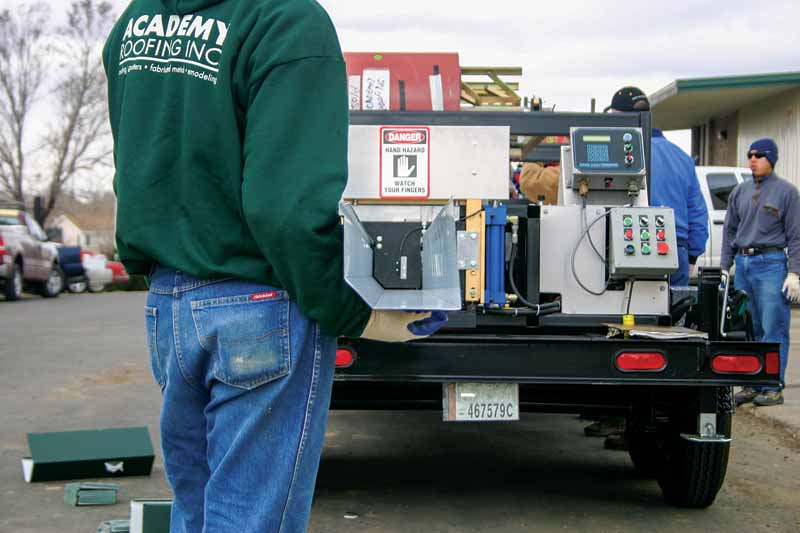
While fascia gutters are popular in the West, K-style gutters are standard throughout most of the country. While 127 mm (5 in.) gutters are typical in most states, areas with significant rainfall such as Florida, lean toward 152.4 mm (6 in.) gutters.
The standard for steel gutters is 26 gauge, but southern regions that experience severe storms often use a heavier 24 gauge. In Canada, the standard is the lighter 28 gauge for gutters. Aluminum has gained popularity due to its durability, capacity to handle heavy rainfall, and rust-resistant properties. However, steel is preferred in regions prone to hailstorms due to its resilience. As regions differ, one will need to determine which machine produces the best gutter for the area.
The next step is to compare machines and their components. For example, push-button controls are easier to use than drum switches, which are cheaper but less durable. A computer controller enables users to program the gutter length but will increase the cost of the machine. Each machine provides numerous options, requiring some research to determine the most suitable one. When deciding on the best gutter machine to purchase, several factors should be considered:
- Common profiles in the region
- Customer preferences (such as appearance, cost, etc.)
- The machine’s production speed (measured in feet per minute)
- Available options and accessories
- Materials and gauges supported by the gutter machine
- Size and cost of the machine
- Transportation requirements (truck and trailer)
- Routine maintenance needs and available training opportunities
For portable gutter machine manufacturers, KWM, NTM, and Englert are some of the most recognizable names in the business. While KWM is one of the country’s largest portable gutter machine manufacturers, NTM has been around for more than 30 years and pioneered polyurethane drive rollers. All three companies offer quality machines with service and training available.
The 127 to 152.4 mm (5 to 6 in.) combo is the most popular gutter machine, as it offers the most flexibility. For residential projects, a combo machine should suffice. However, for industrial or commercial endeavors, consideration may be given to a box gutter or a 177.8-mm (7-in.) portable gutter machine.
Anyone using a portable gutter machine should receive training. Most manufacturers offer in-house or on-site training, sometimes for free with the purchase of a new machine. Also, one should pay attention to maintaining and protecting their portable rollformer—like any equipment, it can be damaged or rust if left out in the elements. The machine should be kept indoors or in an enclosed trailer when not in use.
Conclusion
A portable gutter machine equips contractors with an asset, whether used strictly in a gutter business or for expanding the offerings of an existing roofing operation. Given their durability, easy maintenance, and sleek appearance, the benefits of seamless gutters over prefabricated sectional gutters outweigh the additional costs for any homeowner or commercial enterprise.
Contact a portable seamless gutter machine manufacturer or distributor for more information.
Rick Zand has worked as a freelance writer, college professor, and university director of admissions. He is currently the content specialist for marketing at New Tech Machinery, a manufacturer of portable rollforming machines. He resides in Denver, Colo.



